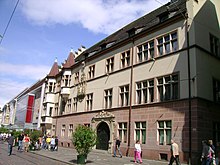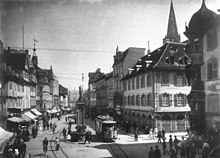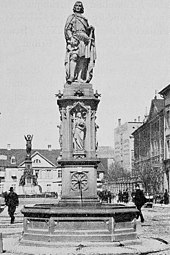Kaiser-Joseph-Strasse (Freiburg im Breisgau)
The Kaiser-Joseph-Strasse (in short form often Kajo called) in Freiburg is a 900 meter long shopping street , which in the middle of the historical old town runs from north to south. Kaiser-Joseph-Straße is one of the most expensive locations in Germany. In 2017 it was the ninth most visited shopping street in Germany.
Location and traffic
The street begins in the north at Europaplatz, where the victory monument stands on the edge of the old town . At the central intersection of Freiburg, at Bertoldsbrunnen, Bertoldstraße goes west and Salzstraße goes east . Then Kaiser-Joseph-Straße leads through the Martinstor at the southern end of the city center to the Kaiserbrücke on the Dreisam . The Freiburger Bächle accompany them to Martinstor . Most of the buildings between the Victory Monument and Martinstor were completely destroyed by bombing during World War II. During the reconstruction, arcades were built in order to gain more traffic area, because the streetcar , which had been running here since 1901, had to share the road with bus routes and the increasing amount of car traffic. Road traffic was regulated by a set of traffic lights at Bertoldsbrunnen. On November 22, 1973, this street and the adjacent ones were closed to private motorized traffic. Today tram line 4 ( Messe - Zähringen ) runs north of Bertoldsbrunnen and lines 2 (Hornusstraße - Günterstal ) and 3 ( Vauban - Haid) south of Bertoldsbrunnen and delivery vehicles - except at Bertoldsbrunnen. These restrictions do not apply to the section south of the timber market.
history
Kaiser-Joseph-Straße was originally called “Große Gass”, where the market was held in the Middle Ages, hence its width compared to the other streets in the old town. In the 15th century, the market was then moved to the square in front of the Freiburg Minster .
The connection between the "Große Gass" and the suburbs in the form of the Martin Gate was interrupted in the 17th century during the construction of the fortress and the leveling of the suburbs by Sébastien Le Prestre de Vauban . The salt road now served as an entrance from the Höllental . However, it was not wide enough for the bridal procession of the future French Queen Marie Antoinette , which consisted of 235 people, 57 wagons and 250 draft and riding horses. In order to be able to give her a befitting reception when she arrived on May 4, 1770, she was supposed to enter the city via Gartenstrasse through the Breisacher Tor. For this occasion, today's Dreisam- und Schreiberstraße was built on the north bank of the Dreisam. In addition, three organizations in Freiburg each erected a triumphal arch for the Dauphine: the city at the Karlskaserne , the university at the Kollegienhaus (today's New Town Hall ) and the estates on the "Große Gass". The latter was the largest of the three arches at 24 meters high and 18 meters wide. It was built from wood and stucco by Johann Christian Wentzinger . In Kageneckschen house in the Salt Route Marie Antoinette took two nights lodging, before continuing to the morning of May 6 Reichsabtei Schuttern went.
After a visit by Emperor Joseph II. In 1777, the street was renamed "Kaiserstraße" in honor of the sovereign. Around 1840 the street was extended south from Martinstor to Dreisam. This section was initially named "Stephanienstraße" in honor of the Grand Duchess Stéphanie de Beauharnais of Baden . Accordingly, the new quarter created in this context was called “Stephanien-Vorstadt”. At the turn of the century there were three fountains on the street: the fish fountain from the 16th century, the Bertolds fountain , which displaced it from its place around 1806, and the Albert Ludwig fountain by Alois Knittel from 1868. It was close by the victory monument on what was then Kaiser-Wilhelm-Platz.
During the time of National Socialism , the rulers gave the Kaiserstrasse together with its extensions to the north (Zähringerstrasse) and south (Günterstalstrasse) the name "Adolf-Hitler-Strasse". After the Second World War , the northern part of this inner-city traffic axis was renamed “Habsburgerstrasse”, the section in the city center up to Dreisam became “Kaiser-Joseph-Strasse” to make it clear that the Habsburg emperor was meant here. Since they did not want to change the existing house numbers, they start in Kaiser-Joseph-Straße at 143 on the east side and at 166 on the west side.
Numerous branches of large trading companies have their business premises in the street. In the 1970s there were five department stores on the street; at the beginning of the 21st century there are still two. The only building without any commercial use is the Basler Hof , which was built by Konrad Stürtzel in the 15th century as a residential building and is now one of the most important secular buildings in Freiburg. It got its name because the Basel cathedral chapter had its exile residence here from 1587 to 1677 - it could no longer survive in Basel due to the Reformation . Today it is the representative office of the regional president of Freiburg .
The Kaiserbrücke from around the turn of the century at the southern end of Kaiser-Joseph-Strasse was once adorned with bronze statues of Salier Heinrich V and Staufer Friedrich Barbarossa by Julius Seitz and the Habsburgs Rudolf I and Maximilian I by Fridolin Dietsche . In 1942 they were dismantled and brought to Hamburg to be melted down. Although this did not happen until the end of the war, the local council refrained from retrieving the statues in 1950 because of the high transport costs. The bulges for the statues can still be seen today.
In the summer of 2014, a mixed water sewer between Bertoldsbrunnen and Martinstor was renewed by bnNetze, which was over a hundred years old, and the tracks were then replaced by VAG . Corresponding work was carried out between Bertoldsbrunnen and Europaplatz from March to October 2017.
Individual evidence
- ↑ Germany's most expensive locations: Here the rent is 260 euros - per square meter , spiegel.de, April 27, 2007, accessed on January 1, 2010
- ↑ Simone Höhl: Freiburg: Ranking list: Freiburg's Kajo surprisingly climbs into the top ten of German shopping miles. Badische Zeitung, April 13, 2017, accessed on April 14, 2017 .
- ↑ Große Gaß , badische-seiten.de, accessed on March 27, 2010
- ^ Badische Zeitung , November 20/21, November 22 and 23, 1973
- ↑ Hans Schadek: Freiburg, formerly - yesterday - today, The city in the course of the last 100 years , Steinkopf Verlag , 2004, p. 58
- ↑ Peter Kalchthaler : Freiburg Mitte: Triumphbogen in Kaiserstraße , Badische Zeitung from May 3, 2010, accessed on December 30, 2010
- ↑ Friedrich Kempf: Public fountains and monuments . in: Freiburg im Breisgau. The city and its buildings , HM Poppen & Sohn, Freiburg 1898, p. 483 ff.
- ^ Peter Kalchthaler : Freiburg ways . Street names with a history. Freiburg im Breisgau, 1998, ISBN 978-3-7930-9244-5 , p. 103 ff.
- ↑ Hans Sigmund: Freiburg: Once flanked by bronze emperors , Badische Zeitung from September 15, 2008, accessed on July 31, 2009
- ↑ Alexandra Sillgitt, Sina Gesell: Freiburg: City center: Large construction site Bertoldsbrunnen: This is coming to Freiburg. Badische Zeitung, June 6, 2014, accessed on March 21, 2017 .
- ^ Daniela Frahm: Freiburg: Projects: Large construction site on Kaiser-Joseph-Straße from March 2017. Badische Zeitung, November 29, 2016, accessed on March 21, 2017 .
Web links
- Kaiser-Joseph-Strasse on Historic Freiburg
- Peter Kalchthaler: This is how Freiburg's Kaiser-Joseph-Straße has changed. In: Badische Zeitung . March 13, 2017. Retrieved March 17, 2017 .
Coordinates: 47 ° 59 ′ 40.6 ″ N , 7 ° 50 ′ 58.9 ″ E





